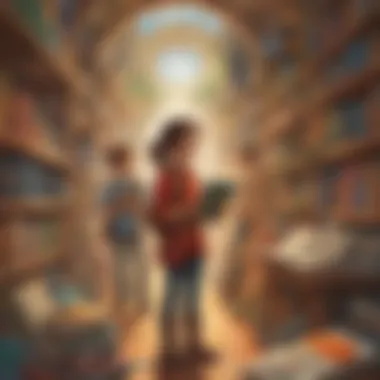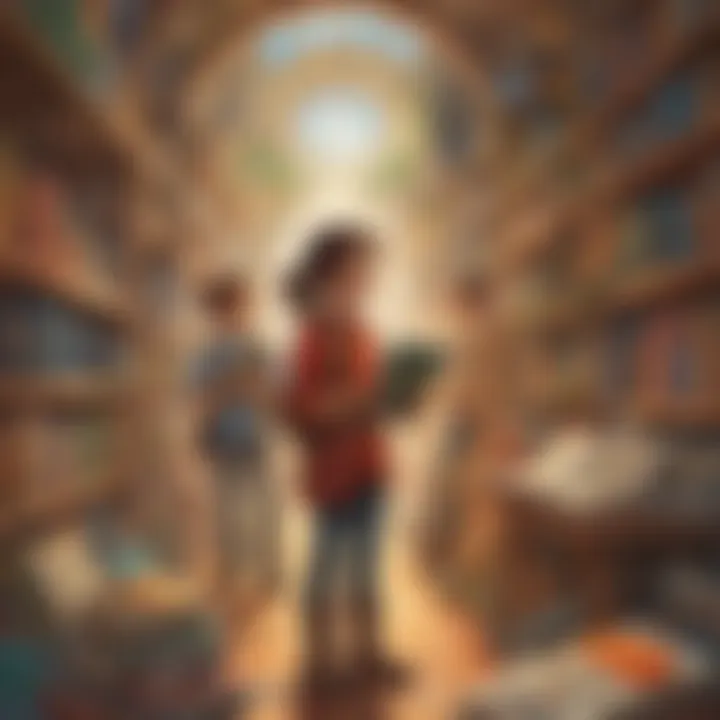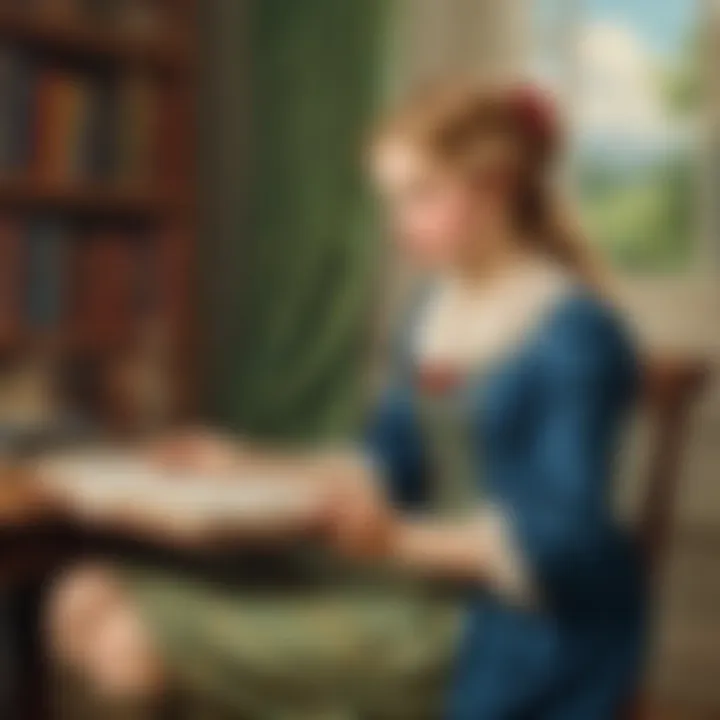Top Best Selling Books for Engaging 4th Graders


Intro
In today’s rapidly evolving literary landscape, identifying the right books for fourth graders can be a daunting task. This stage marks a crucial point in their cognitive development, as many children begin transitioning from simple narratives to more complex themes and characters. Selecting the right literature not only fosters a love for reading but also enhances their critical thinking skills. To assist parents, caregivers, and educators, this article will explore the best-selling books that have captured the attention of young readers while enriching their understanding of the world.
Creative Activities
Engaging young readers through creative activities can deepen their appreciation for literature. By relating to what they read, children can better internalize themes and characters. Here are some suggestions for creative activities related to popular fourth-grade books:
Craft Ideas
Children can express their creativity by replicating scenes from books or creating their own interpretations. For instance, if a child reads "Charlotte's Web," they might create paper webs or illustrations of each character. Other ideas might include:
- Making bookmarks that represent their favorite book characters.
- Designing a cover for a favorite book.
- Sculpting favorite scenes using clay.
Step-by-Step Guides
To facilitate engagement, a structured approach to these activities can be beneficial. For example, creating a character mask involves several steps:
- Choose a character from a book.
- Gather materials like cardboard, scissors, and markers.
- Outline the mask shape and cut it out.
- Decorate it based on the character’s features.
- Attach a string to wear it.
Educational Value
These activities provide not just entertainment but also various educational benefits. They encourage motor skills development through crafting while stimulating imagination and narrative skills. Children learn to connect ideas and express personal interpretations of stories, fostering deeper comprehension.
Fun Quizzes
Quizzes can serve as an interactive way to reinforce learning. They gauge a child's understanding of the material they read. Here are some aspects of the quizzes that could attract young learners:
Quiz Topics
Quizzes can cover varied topics based on genres, themes, and specific books, making learning more dynamic. For example:
- Understanding character motivations.
- Identifying the main idea of a story.
- Exploring moral lessons.
Question Types
Engaging children with diverse question types helps keep them interested:
- Multiple choice questions that prompt them to think critically.
- True or false statements to encourage quick evaluations.
- Short answer questions that elicit deeper comprehension.
Knowledge Reinforcement
These quizzes reinforce knowledge by allowing children to revisit key concepts. Immediate feedback helps to consolidate learning. Such interaction with the material can enhance retention and encourage a continuous engagement with literature.
Fact-Based Articles
Supplementing reading with fact-based articles can introduce context and expand themes covered in books. Here’s how these articles can be structured:
Topics
Articles could explore a range of topics, such as:
- The history behind classic children’s literature.
- Biographies of beloved authors like J.K. Rowling or Roald Dahl.
- Themes of friendship and courage in young adult literature.
Engaging Content
Presenting information in an accessible manner is vital. The aim should be to make complex ideas relatable:
- Using simple language and clear explanations.
- Including visuals to support understanding.
- Breaking down articles into bullet points for easier consumption.
Prolusion to Children's Literature
Children's literature plays a pivotal role in shaping the minds of young readers. At the fourth-grade level, the cognitive skills and interests of children begin to diversify. This stage is crucial as they transition from learning to read to reading to learn. Engaging with well-selected books fosters curiosity, promotes empathy, and enhances critical thinking skills.


Importance of Reading at a Young Age
Reading is a fundamental skill that goes beyond simple words on a page. It builds a child's vocabulary, develops their imagination, and improves concentration. Studies show that children who read regularly perform better academically. Moreover, books provide a window into diverse cultures and experiences, broadening a child's understanding of the world. Parents and educators should recognize that the books children choose at this age can significantly influence their future relationship with reading.
Catering to the Fourth Grader's Mindset
Fourth graders are at a unique stage of cognitive development. They have the ability to comprehend more complex narratives but still enjoy relatable characters and engaging plots. Books need to resonate with their experiences and emotions. Factors such as humor, adventure, and mystery often captivate this age group.
Moreover, the social dynamics of fourth graders require titles that encourage friendship and teamwork. Books that feature issues relevant to their lives help them navigate their feelings and peer relationships. Therefore, selecting suitable literature means understanding not just what they can read, but what they want to read.
Choosing the right books nourishes a child's love for literature, paving the way for lifelong learning and enrichment.
Understanding the Best Selling Books
Understanding the best selling books for fourth graders is crucial for parents, educators, and guardians. This age group is at a formative stage where reading habits and preferences begin to take shape. Identifying the characteristics of popular literature can greatly influence children’s literacy and critical thinking skills. In this section, we will provide insight into the criteria used for selecting these books, and discuss their impact on young minds.
Criteria for Selection
Choosing the right books for fourth graders involves several essential criteria that cater to their cognitive and emotional development. These books should engage young readers, promoting not only enjoyment but also learning.
- Age Appropriateness: The vocabulary and themes should be suitable for 9-10 year-olds. Books need to avoid complex themes that might overwhelm them.
- Relatable Characters: Stories that include characters children can identify with tend to resonate more. This connection fosters empathy and understanding.
- Diversity of Genres: A mix of genres such as adventure, mystery, and science is important. Each genre brings a unique flavor, allowing children to explore different worlds and ideas.
- Educational Value: Books should promote critical thinking and curiosity. They should encourage inquiry and explorations of new concepts.
- Positive Messages: Literature should instill values such as kindness, resilience, and perseverance. Understanding these values is important at a young age.
Impact on Young Readers
The impact that best selling books have on young readers cannot be overstated. These books do far more than entertain; they play a crucial role in shaping thoughts and behaviors.
- Enhanced Literacy Skills: Exposure to rich language and engaging stories improves reading skills. Children develop vocabulary and comprehension naturally through context.
- Critical Thinking Development: Books that challenge situations require kids to think critically about characters’ decisions. This reflection helps develop analytical skills needed in higher education and life.
- Imagination and Creativity: Literature opens the door to limitless possibilities. When children read, they learn to visualize scenarios and think creatively.
- Cultural Awareness: Best selling books often present diverse cultures and histories. Reading about different backgrounds expands a child's worldview and fosters acceptance.
Reading is not just a skill; it is a gateway to understanding the world. Selecting the right books can make a lasting impact on a child’s growth.
Understanding the nuances of selecting best selling books ensures that children receive literature that enriches their lives. Through carefully chosen books, young learners can develop a profound love for reading that lasts a lifetime.
Popular Genres for Fourth Graders
The genre of a book can greatly influence a child's reading experience. Understanding these popular genres for fourth graders helps in selecting appealing and age-appropriate literature. Kids at this age are forming their preferences and interests, which can enhance their reading journey. Genres like adventure, mystery, and science fiction can ignite their imagination and curiosity. Thus, recognizing these categories is essential for fostering a love for reading among young learners.
Adventure and Fantasy
Adventure and fantasy books transport young readers to imaginative worlds. Titles in this genre engage children’s creativity and sense of exploration. They encounter challenges and heroes, learning about bravery and resilience. Stories featuring characters on quests often captivate fourth graders, as they enjoy the thrill associated with unexpected turns and discoveries. Series such as Percy Jackson and the Olympians by Rick Riordan integrate mythology into adventure, making it both educational and entertaining. This blend of learning and fun can be a catalyst for lifelong reading habits.
Mystery and Thriller
Mystery and thriller genres stimulate critical thinking. As young readers follow clues and try to solve puzzles, they enhance their analytical skills. Books like The Boxcar Children by Gertrude Chandler Warner allow children to immerse themselves in stories where they must deduce what happens next. Despite being engaging, mysteries can also foster patience and persistence, as solutions may not be immediately visible. This genre encourages kids to be observant and use their reasoning skills, which are invaluable for their overall development.
Science Fiction and Magic
Science fiction and magic genres open the door to possibility. These books often explore futuristic themes, innovation, and the universe. Titles such as A Wrinkle in Time by Madeleine L'Engle provide insights into space travel and time, sparking interest in STEM fields. Magic stories, like Harry Potter by J.K. Rowling, introduce aspects of friendship and challenges in a fantastical setting. The overlap of science and magic invites children to ponder what if scenarios, fostering a spirit of inquiry and imagination.
Historical Fiction
Historical fiction gives context to the past, making history relatable and engaging. Books like Number the Stars by Lois Lowry teach fourth graders about significant events and figures in a narrative format. Such literature not only enriches their understanding of history but also instills values of empathy and cultural awareness. By experiencing different historical periods through characters, children become more invested in learning about the world’s diverse stories.
Non-Fiction and Biographies
Non-fiction and biography books provide factual insights and real-life stories. These genres help children understand values, perseverance, and achievements of notable figures. Books like Who Was Albert Einstein? introduce young readers to inspiring lives and make complex subjects simpler and more accessible. Engaging with non-fiction expands vocabulary and fosters a love for learning about the world. This genre is crucial as it builds general knowledge that supports academic growth and informed citizenship.
Best Selling Books Recommendations
The exploration of best selling books for fourth graders holds tremendous significance. At this age, children are not only developing their reading skills but also expanding their imaginations. Selecting titles that resonate with their interests is key to fostering a love for reading. Best selling books often provide a blend of engaging stories, relatable characters, and educational value. They allow young readers to connect with diverse ideas and experiences, facilitating both personal and intellectual growth.
Top Adventure Stories
Title One: Harry Potter and the Sorcerer's Stone


Harry Potter and the Sorcerer's Stone captivates young minds through its exciting plot and dynamic characters. This first book in a series introduces readers to the magical world of Hogwarts. Its contribution lies in the way it encourages imagination and creativity. Children find themselves enchanted by the concept of a hidden world filled with wonder.
The key characteristic of this book is its ability to mix adventure with themes of friendship, courage, and self-discovery. It is a profoundly beneficial choice as it lays the foundation for critical thinking about good versus evil. The unique feature of Harry Potter is its rich world-building which has inspired discussions among readers of all ages. However, it might be considered a disadvantage for those who prefer more realistic stories, as the fantasy elements can be too far removed from the real-world experiences of some children.
Title Two: Percy Jackson & The Olympians: The Lightning Thief
Percy Jackson & The Olympians: The Lightning Thief brings Greek mythology to life, making ancient tales accessible to modern young readers. This book's specific aspect is its captivating approach to mythology, allowing children to learn while being entertained. It is also lauded for its strong protagonist, making it a relatable and thrilling choice.
The key characteristic of this book is its engaging narrative, which combines humor, adventure, and mythology. It effectively serves the purpose of introducing kids to classical literature in a manner that is exciting and understandable. The unique feature of The Lightning Thief is its ability to weave lessons about identity and belonging into a fast-paced adventure. A potential disadvantage could be its reliance on prior knowledge of Greek mythology, although it does a commendable job of providing context throughout the story.
Engaging Mysteries
Title Three: The Westing Game
The Westing Game is a clever mystery that encourages young readers to think critically about clues and character motives. This book's specific aspect lies in its intricate plot and the challenge it presents. Readers are drawn into solving the mystery alongside the characters, making it an interactive experience.
Its key characteristic is the unique structure of the story, which incorporates a variety of diverse characters. This variety makes it a beneficial choice, as it promotes inclusivity and representation. The unique feature of The Westing Game is the puzzle-like narrative that requires collaboration among readers to uncover the truth. However, some young readers may find the complex plot challenging to follow.
Title Four: Nancy Drew Mystery Stories: The Secret of the Old Clock
The classic Nancy Drew Mystery Stories: The Secret of the Old Clock invites young readers into the life of an adventurous and smart detective. Its specific aspect is how it showcases a female protagonist in a traditionally male-dominated genre. This representation makes it particularly relevant for young girls seeking role models in literature.
The book’s key characteristic is Nancy's resourcefulness and intelligence. This aspect resonates well with readers, inspiring them to think critically. Additionally, its unique feature is the parallel narratives that all converge into a satisfying conclusion. A common disadvantage might be its age, as modern readers may prefer more contemporary styles of writing.
Magical Tales
Title Five: The Chronicles of Narnia: The Lion, the Witch and the Wardrobe
The Lion, the Witch and the Wardrobe introduces children to a magical land filled with adventure and moral lessons. This specific aspect combines fantasy with allegorical elements, making it a rich text for both enjoyment and discussion. This book’s character development and moral choices enhance the overall theme of good versus evil.
Its key characteristic is world-building; C.S. Lewis creates an enchanting realm that sparks imagination. This makes Narnia a popular choice among readers of all ages. The unique feature of this book is its ability to explore deeper themes such as sacrifice and redemption in a captivating way. However, some may find the allegorical elements less appealing if they prefer straightforward fantasy narratives.
Title Six: Ella Enchanted
Ella Enchanted is a fresh twist on the classic Cinderella story. It reinterprets the tale by incorporating themes of autonomy and personal strength. This book’s specific aspect is the protagonist’s journey toward breaking free from enchantments, making it relatable for children facing their own challenges.
This book’s key characteristic is its emphasis on empowerment through agency rather than passive waiting for rescue. It appeals to readers looking for modern interpretations of traditional stories. The unique feature of Ella Enchanted is its comedic tone combined with serious themes. However, some readers might find the premise overly familiar and less inventive.
Historical Adventures
Title Seven: Number the Stars
Number the Stars offers a poignant perspective on World War II through the eyes of a young girl. The specific aspect of this book is its ability to simplify complex historical events for young readers. This approach provides them with both emotional depth and crucial knowledge about history.
The key characteristic of this book is its focus on bravery and the impact of everyday choices. It is a beneficial choice for developing empathy among young readers. The unique feature of Number the Stars is its blend of historical fact with a personal narrative that aids in retention. However, the sensitive topics involved may be challenging for some readers to process emotionally.
Title Eight: The Magic Tree House: Dinosaurs Before Dark
Dinosaurs Before Dark engages readers with time travel to the age of dinosaurs. The specific aspect that stands out is the adventurous spirit that permeates the story, captivating the attention of young readers. This book introduces concepts of history often left out of simplified narratives, making it educational.
Its key characteristic is the format, which blends history with adventure seamlessly. This format has made it a celebrated series in children's literature. The unique feature of The Magic Tree House is its incorporation of educational elements on various historical topics while keeping the narrative lively. One disadvantage may be that some older readers could quickly outgrow its simplicity.
Informative Reads
Title Nine: The Who Was? Series
The Who Was? series provides an engaging overview of significant historical figures. This series’ specific aspect is its concise and age-appropriate information, ideal for fourth graders. The format allows for a smooth introduction to biography and history, making it a valuable educational tool.
The key characteristic of this series is its entertaining storytelling style that avoids dry facts. This quality makes it a popular choice for both students and educators. The unique feature is the visual appeal with illustrations that keep interest levels high. However, the brevity of each book may leave readers wanting to learn more in-depth facts.
Title Ten: National Geographic Kids: Weird But True!
National Geographic Kids: Weird But True! presents fun facts in an informative way. The book’s specific aspect is its engaging content that sparks curiosity about the world. Each page offers fascinating trivia that broadens knowledge in a lighthearted manner.


The key characteristic is the vibrant visuals and photographs that accompany the text. This makes it beneficial for visual learners and enhances understanding. The unique feature of Weird But True! is its entertaining format that encourages learning for pleasure. One disadvantage may be its less serious tone, which might not appeal to all young readers looking for more narrative depth.
Recommendations from Educators
Educators play a crucial role in selecting books that are not only engaging but also aligned with educational standards. Their insights can greatly enhance a child's reading journey. Recommendations from educators help in identifying books that foster comprehension and critical thinking. This section will discuss the importance of teachers' favorites and how they relate to Common Core standards and reading levels.
Teachers' Favorites
Teachers often have a deeper understanding of what resonates with their students. They consider factors like grade-level appropriateness, theme relevance, and cognitive engagement. Here are some notable favorites:
- "Wonder" by R.J. Palacio: This novel promotes empathy and kindness. It encourages discussions about differences.
- "The Tale of Despereaux" by Kate DiCamillo: This story is rich in moral lessons, suitable for enriching classroom discussions.
- "The One and Only Ivan" by Katherine Applegate: A powerful narrative that explores friendship and captivity.
These titles not only entertain but also provide an opportunity for educators to integrate meaningful discussions into their curriculum.
Common Core and Reading Levels
Understanding Common Core standards is essential for matching books to the right reading levels. The standards emphasize both comprehension and analytical skills.
Books recommended by educators are usually informed by these criteria:
- Complexity: Educators assess if the text is age-appropriate and offers challenges that foster growth.
- Themes: Themes related to relationships, identity, and ethics are significant as they align with educational goals.
- Diversity in Literature: A variety of backgrounds and perspectives help broaden students' worldviews.
"Reading is not just a skill; it is a gateway to understanding the world."
Incorporating books that meet these standards helps students develop critical thinking skills necessary for their academic growth.
Creating a Reading Culture
Creating a reading culture is essential in nurturing a positive relationship with literature, especially for fourth graders. At this age, children's cognitive skills are developing rapidly. They begin to comprehend complex ideas and narratives. Fostering an environment that values reading can significantly impact their academic and personal growth.
A reading culture encourages children to engage with books regularly. It cultivates curiosity and imagination, critical for their intellectual development. When children see reading as an enjoyable and integral part of their lives, they are likely to become lifelong learners. In addition, children develop important literacy skills, such as comprehension and vocabulary. This process naturally enhances their confidence in both written and spoken communication.
The role of parents, educators, and caregivers is crucial in this endeavor. By demonstrating enthusiasm for reading and sharing stories, adults can inspire children to explore various genres and authors. This nurturing environment can lead to a deeper appreciation of literature and its diverse forms.
Encouraging Daily Reading Habits
Daily reading habits can be established through small but effective strategies. Setting aside a specific time each day for reading can create a reliable routine. This routine could be during breakfast, before bed, or any time that fits into family schedules. Ensuring a distraction-free space can enhance focus and enable children to immerse themselves in stories.
Additionally, incorporating a selection of engaging books is vital. Parents can offer a mix of genres to cater to their child's interests. This selection could include current bestsellers, classics, or even graphic novels. It is important to mention that allowing children to choose their own books can empower them and make reading feel less like a chore.
The End
In this article, we have explored the significance of selecting appropriate literature for fourth graders. Reading at this age is crucial as it shapes their understanding of the world and improves literacy skills. The recommendations discussed highlight books that not only entertain but also educate. They encourage young readers to think critically, fostering their imagination and empathy.
Recap of Recommendations
The recommendations include a mix of adventure, mystery, magical tales, and informative reads. Each title has been chosen based on its ability to engage young minds. Some notable mentions are Holes, which combines adventure and resilience, and The One and Only Ivan, a touching narrative that promotes compassion for animals.
- Top Adventure Stories:
- Engaging Mysteries:
- Magical Tales:
- Historical Adventures:
- Informative Reads:
- Holes
- Percy Jackson & The Olympians: The Lightning Thief
- The Westing Game
- Nancy Drew: The Secret of the Old Clock
- The Magic Tree House Series
- Harry Potter and the Sorcerer's Stone
- Number the Stars
- The Wright Brothers: How They Invented the Airplane
- Hidden Figures: The True Story of Four Black Women and the Space Race
- The Diary of a Young Girl by Anne Frank
Final Thoughts on Choosing Books
When selecting books for fourth graders, it is essential to consider their interests and reading levels. A balance between challenging and easy reads can help maintain their motivation and enthusiasm for reading. Pay attention to themes that resonate with their experiences and provide relatable situations.
Parents can encourage discussions about the books to enhance understanding and critical thoughts.
Choose literature that sparks curiosity about the world. Always remember that fostering a love for reading can lead to lifelong learning.
Reading is fundamental to growth—both academically and personally.
Through these recommendations and insights, we hope to guide young learners and their caregivers toward making informed choices in their reading adventures.







